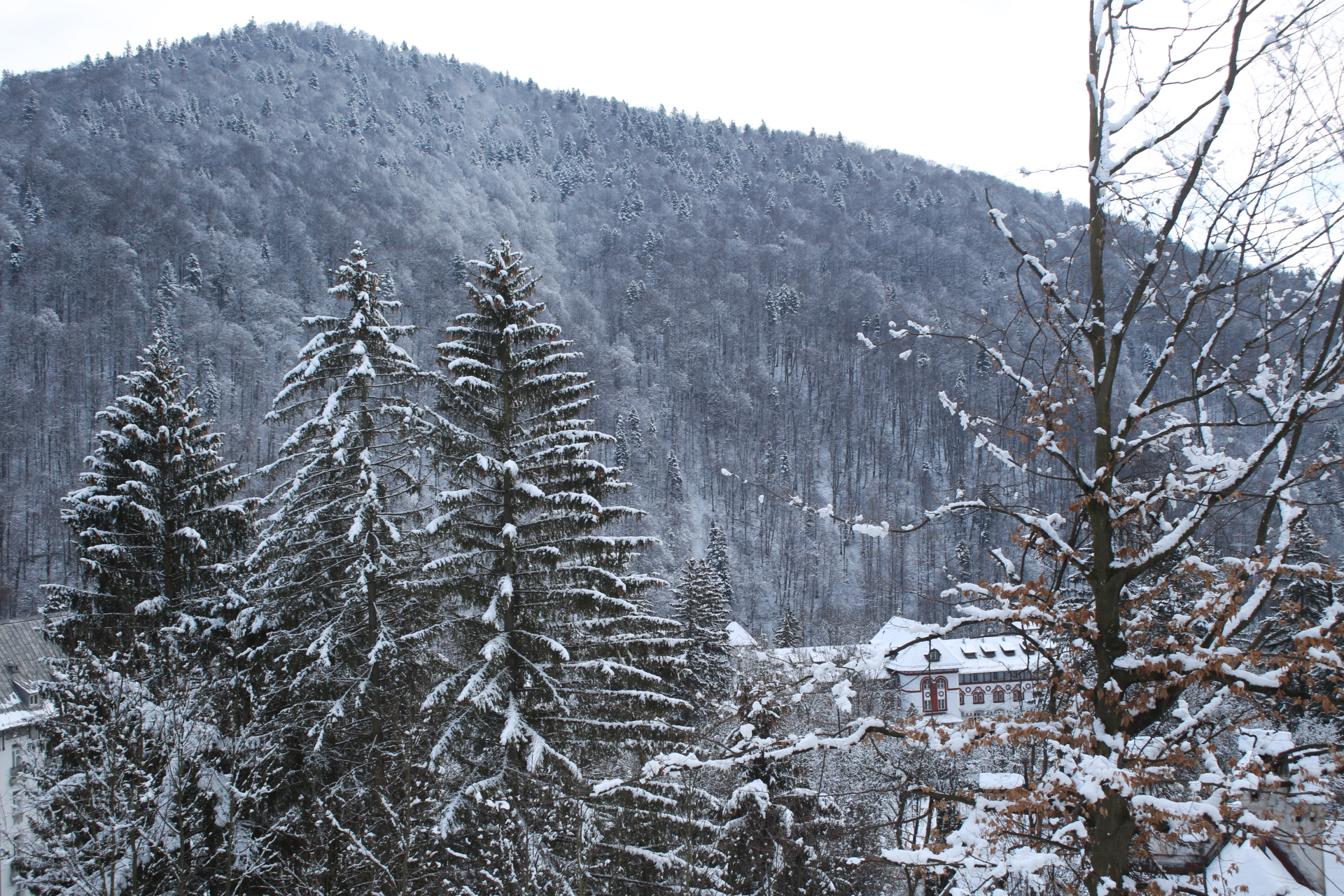Doi străini trăind sărbătorile de crăciun în România
/Andrea și Gertrudis au scris acest articol în engleză. Pentru a citi originalul, vezi textul mai jos./
Noi suntem Gertrudis și Andrea, voluntari ai asociației ‘’Curba De Cultură’’ aici în România, mai exact în comuna Izvoarele (Prahova). De-a lungul acestui an, suntem implicați în proiectul ‘’Discover Teisani’’ (Descoperă Teișani): inițiativă pentru a promova comuna și locuitorii Teișaniului utilizând conținut audio-vizual, articole și multe alte materiale. Cu toate astea, astăzi suntem aici pentru a vorbi despre altceva.
Acest articol este pentru toți cititorii curioși ce vor să știe cum se sărbătorește în alte țări de Crăciun și Anul Nou. Vom vorbi despre ceea ce am văzut, despre experiențele trăite, despre senzațiile și sentimentele pe care le-am trăit în primul nostru festival ca străini.
Toată lumea știe că venirea Crăciunului este deseori sinonim cu apariția decorațiunilor: orice tip de ornamente, lumini și LEDuri de toate formele și culorile, Moși Crăciuni tăcuți în mijlocul de a se cățăra pe fiecare terasă… Din experiențele noastre trecute am crezut că le-am văzut pe majoritatea. Ne-am înșelat, căci din păcate nu fusesem în România înainte. Să spunem că a fost incredibil nu e suficient, felul cum de pe-o zi pe alta fiecare casă s-a aprins, transformând strada liniștită de țară în ceva mai similar cu felul cum ne imaginăm că ar fi o stradă din cartierul chinezesc (Chinatown).
Puteam deja în acele zile să simțim spiritul Crăciunului sau, cel puțin, puteam simți că etapa pregătitoare era în curs de desfășurare. Apoi, zi după zi, din ce în ce mai mulți oameni au început să se deplaseze spre sat. Mai multe strigăte, mai multă muzică, mai mult petrecut. Cu toate astea, momentul exact în care am perceput în sfârșit că e sărbătoare a fost trezitul în acea dimineață înmuiată de un cântec, canto. Am descoperit ulterior că am auzit ”colindatul”, colindele de Crăciun. În esență această tradiție constă într-un grup de persoane cântând la instrumente și vocal cântece, aceștia mergând din casă în casă. Originar, colindele de Crăciun aveau funcție de ritual, mai exact aceea de a ura fertilitate și abundență. Astăzi, scopul comun al colindelor este acela de a alunga spiritele rele ale lui ianuarie și de a ura un Crăciun și An Nou fericite, creând o atmosferă colorată și magică.
Crăciunul se apropia, iar satul era în priză. Aerul era acum plin de pocnitori, muzică tradițională și pocniturile biciurilor fluturate de băieți. Ultima dintre acestea, la fel ca în cazul colindelor de Crăciun, este o tradiție bine fondată: băieții flutură un bici lung în aer, producând pocnituri tunătoare. Primele câteva dăți când am auzit acel sunet am crezut că erau focuri de armă. Sună destul de puternic, și chiar este, pentru a alunga spiritele rele.
Neașteptatul punct culminant al sărbătorilor a venit de Ajunul Anului Nou. Nu am fi crezut niciodată că odată cu miezul nopții cerul de deasupra Izvoarelor va fi colorat de o multitudine de artificii. Pentru acele minute intense artificiile au apărut dintr-o parte în alta, fără răgaz. Până și casa din fața noastră a decis să ia parte în acest dans. Odată cu căderea cenușii lăsate de artificii am mers în stradă, purtând măști și, purtați de euforie, am cunoscut doi copii care erau și ei purtați de euforia de a cunoaște străinii din zonă. A durat ceva, puține cuvinte dar multe gesturi, și ne-am trezit absorbiți într-un dans, condus de copii. Într-un cerc, ținându-ne unii de alții, am urmărit muzica care nu ne-a părăsit vreodată, mereu în fundal. A fost un final potrivit, un rămas bun al anului care ne-a lăsat într-o dispoziție pozitivă de care aveam nevoie pentru a continua planificarea următoarei explorări.
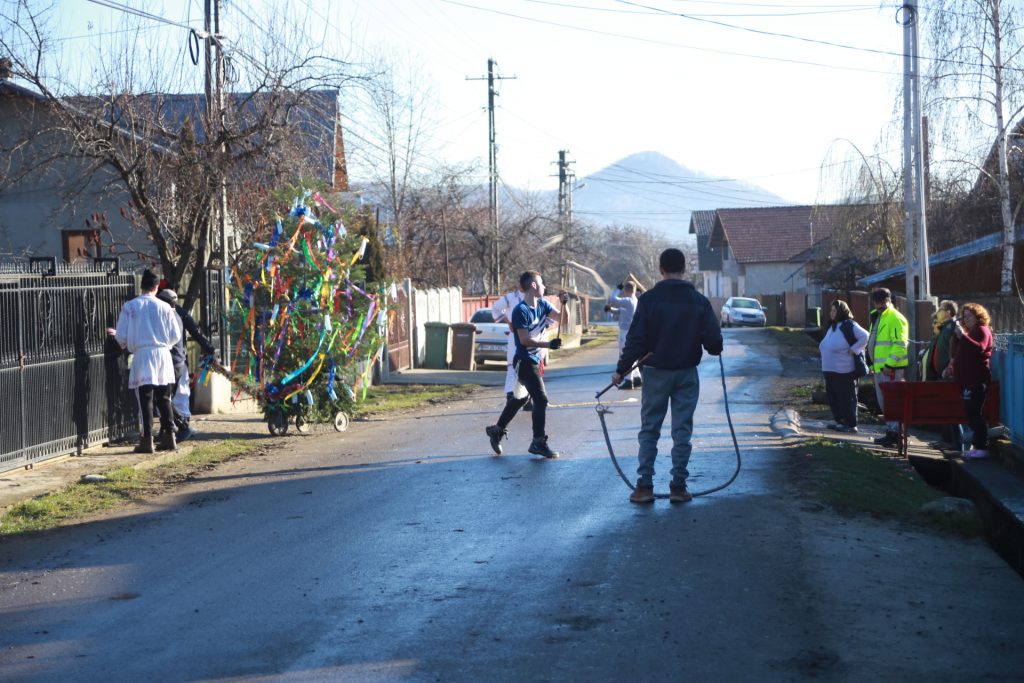
Desigur, drumețiile în zonele din jur a fost absolut obligatorie. Prahova este un județ minunat pentru cei care iubesc natura. Numai în Izvoarele era un traseu liniștit mergând spre Schiulești și, odată acolo, poți continua până la Mănăstirea Crasna. Pe lângă asta, a meritat să vizităm dealurile din Teișani. Iarna oferă o atmosferă magică odată ce se așterne zăpada, dar chiar și înainte te poți bucura de diversitatea culorilor ce rămân din timpul toamnei. Am mers în drumeție de asemenea în SInaia, unde a fost surprinzător de liniștit. Deși tot turismul din Sinaia pare concentrat pe schiat, cărările pentru a ajunge la nivelul de 1450 m erau goale, iar noi am avut sentimentul că toată imensitatea naturii era pentru noi. Cu siguranță, trebuie să fi pregătit cu energie și pantofi potriviți pentru un astfel de plan. Cu toate astea, poți de asemenea găsi și activități mai relaxante în Sinaia, precum vizitarea castelului Peleș. Acolo, îți vor fi introduse un mix de stiluri (turcesc, maur, venețian, al lui Louis IV…) și rafinatul lucru în lemn care caracterizează clădirea.
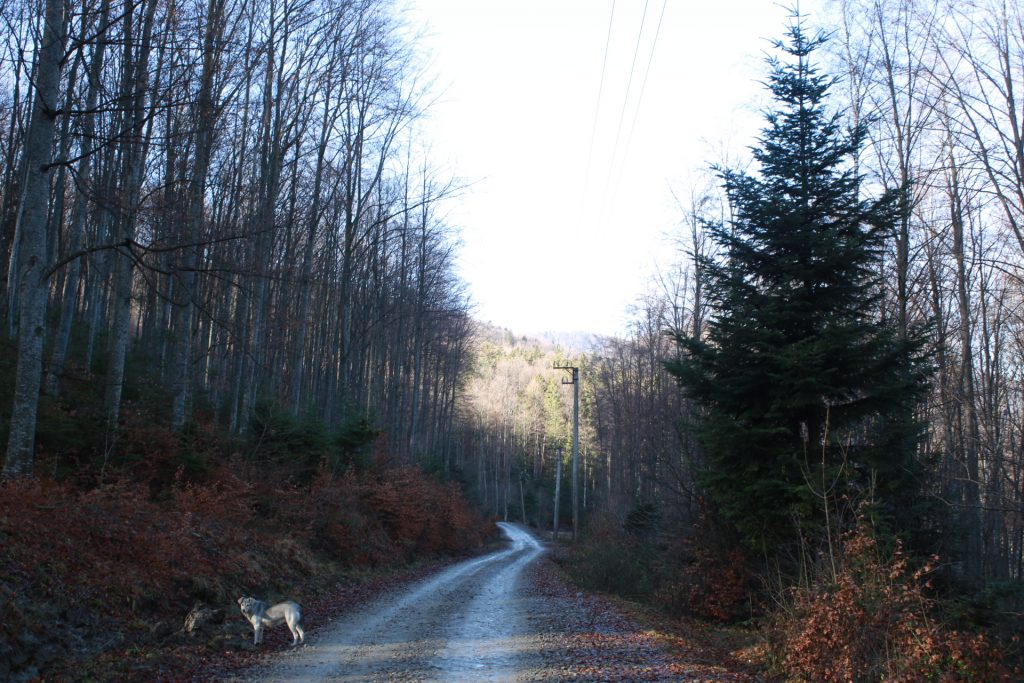
Nu putem termina fără să menționăm că am avut șansa să vizităm Bucureștiul în timpul sărbătorilor. Ne-a dat o impresie similară a unui loc plin de viață cu un mix interesant de stiluri în ceea ce privește clădirile. Nu în același fel, dar de asemenea atractiv. Cu cantitatea de lumini, noaptea a fost îndeosebi vie în centrul vechi. A trebuit să fim în capitală pentru a ajunge în Sinaia cu trenul. Am avut norocul de a ne urca într-un tren internațional istoric și frumos spre Viena, unul cu compartimente separate. Cu siguranță trenurile din România merită un alt articol în viitor.
În scurtul timp în care am fost în București, am putut vizita câteva librării. Acestea erau pline de decorațiuni șic de Crăciun. Cu toate astea, privirile noastre au mers direct spre rafturi de parcă căutau comori. Aceste locuri, la fel ca și bibliotecile, par să păzească într-un loc spațiu foarte mic o cantitate enormă de cunoaștere despre cultura unei țări. Nu doar datorită conținutului cărților în sine, dar și prin felul cum rafturi sunt așezate, subiectele și autorii de care sunt interesați..
În concluzie, suntem fericiți că acesta este doar începutul călătoriei noastre. Prin ”Discover Teișani” suntem în locul perfect pentru a ne satisface curiozitatea interioară, care se așteaptă să aprecieze toată bogăția acestei țări.
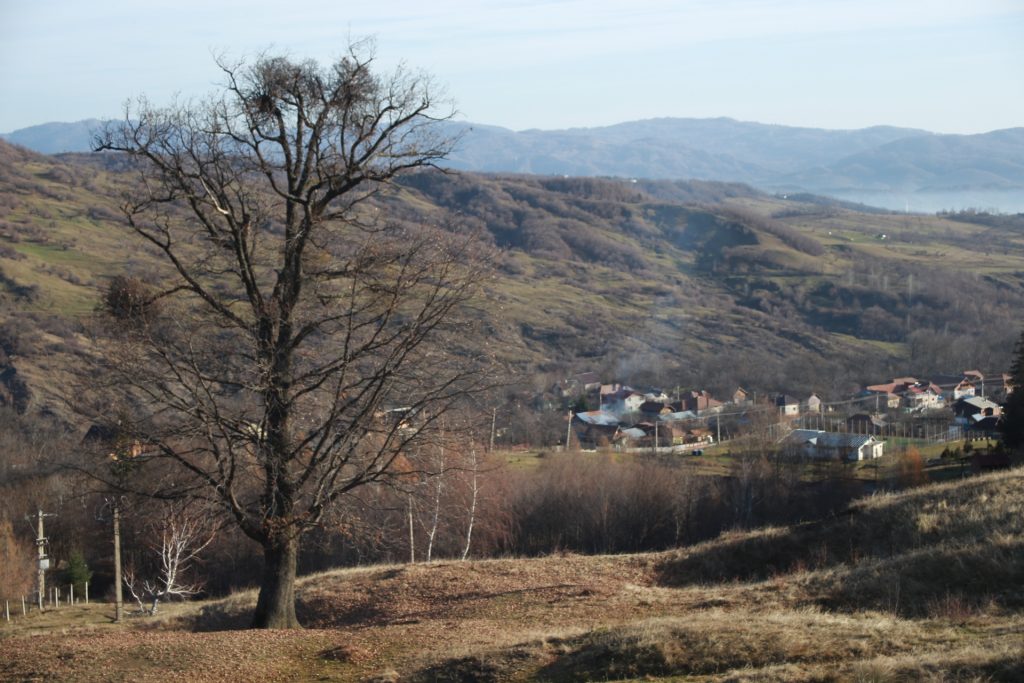
/Original title: Two foreigners living winter holidays in Romania/
We are Gertrudis and Andrea, volunteers of the association ‘’Curba De Cultură’’ here in Romania, precisely in the comune of Izvoarele (Prahova). For this year, we are involved in the project ‘’Discover Teisani’’: the initiative for promoting the commune and the citizens of Teișani utilizing audio-visual content, articles and many other materials. Nevertheless, today we are here to talk about something else.
This article is for all the curious readers who want to know about how it is celebrated in other countries on Christmas and New Year’s Eve. We will talk about what we saw, the experiences lived, the sensations and feelings we felt in our first fest as a foreign.
Everyone knows that the arrival of Christmas is often synonymous with the arrival of decorations: any type of ornament, lights and LEDs of all forms and colours, silent Santa Claus in the middle of climbing on every terrace … From our past experience we thought we had seen most of them. We were wrong, alas we had never been in Romania before. It was incredible, to say the least, how from one day to the next every house suddenly turned on, transforming the quiet country road into something more similar with how we imagine a street in Chinatown would be.
We could already feel in those days the Christmas spirit or, at least, we could feel that the preparatory phase was underway. Then, day after day, more and more people began to flock to the village. More shouting, more music, more partying. However, the exact moment in which we finally perceived to be in celebration was the awakening on that morning softened by a song, a canto. We discovered later that we heard the ‘’colindat’’, the Christmas carols. Basically that tradition consists of a group of people playing instruments and singing songs goes from one house to another. Originally, Christmas carols had a ritual function, namely that of wishing fertility and abundance. Today the common purpose of carols is to chase away the bad spirits of January and to wish a merry Christmas and the New Year’s Eve, creating a colourful and magical atmosphere.
Christmas was upon us and the village was fermenting. The air was now filled with the firecrackers, traditional music and the cracking of whips waved by the boys. The latter, as the Christmas carols, is a well-founded tradition: the boys wave a long whip in the air, producing thundering pops. The first few times we heard that sound we thought it was gunshots. Sound powerful enough, it is thought, to ward off evil spirits.
The unexpected climax of the holidays came on New Year’s Eve. We would never have thought that with the click of midnight the sky above Izvoarele would be coloured by a multitude of fireworks. For those intense minutes fireworks appeared from one side to the other, without respite. Even the house opposite ours decided to take part in that crackling dance. With the fall of the ashes left by the fireworks we went down the street, wearing masks, and taken by the euphoria, we met two kids who were also taken by the euphoria of meeting the strangers in the zone. It took a little, a few words but many gestures and we found ourselves immersed in a dance, led by the kids. In a circle, holding each other, we followed the music that never left us, always in the background. It was a worthy ending, a year’s farewell that let us in the positive mood we needed to continue planning the next explorations.
Of course, hiking in the surrounding areas was a must. Prahova is a great county for those who love nature. Just in Izvoarele, there is a quiet path going to Schiulesti and, once there, you can continue until the Crasna Monastery. Besides, it is worthwhile visiting the hills in Teisani. Winter provides a magical atmosphere once the snow arrives, but even before you can enjoy the diversity of colours that remains from the autumn. We also hiked in Sinaia and it was surprisingly calm. Although the tourism in Sinaia seems focused on skiing, the paths to arrive at the level 1450m were empty, and we had the feeling that all the immensity of nature was for us. For sure, you need to be prepared with energy and proper shoes for this kind of plan. However, you can also find more relaxed activities in Sinaia, such as visiting the Peleș Castle. There, you will be introduced in a mixture of styles (Turkish, Moorish, Venetian, Louis IV…) and the refined work in the wood that characterizes the building.
We cannot finish without mentioning that we had the chance to visit Bucharest during these holidays. It gave us a similar impression of a lively place with an interesting mix of styles in buildings. Not in the same way, but likewise attractive. With the amount of lights, the night was particularly alive in the old town. We had to be in the capital to arrive in Sinaia by train. It was lucky to get on an historical and beautiful international train heading to Vienna, ones with separate compartments. For sure, trains in Romania deserve another article in the future.
In the short time we were in Bucharest, we could visit a couple of bookstores. They were full of fancy decorations for Christmas. However, our eyes glanced directly at the shelves as they were looking for a treasure. These places, as well as the libraries, seem to safeguard in a very small space an enormous amount of knowledge about a country’s culture. Not only because of the content of the books themselves, but also because of the way the shelves are arranged, what subjects and authors they are interested in…
In conclusion, we are happy that this is only the beginning of our journey. Through ‘’Discovering Teisani’’ we are in the perfect place to satisfy our inner curiosity, which is expecting to appreciate all the wealth of this country.
Samuel Paty…
Today I want to tell you, about an event that impacted my life as a volunteer, person and citizen. This event happened in France, on the 16th of October 2020.
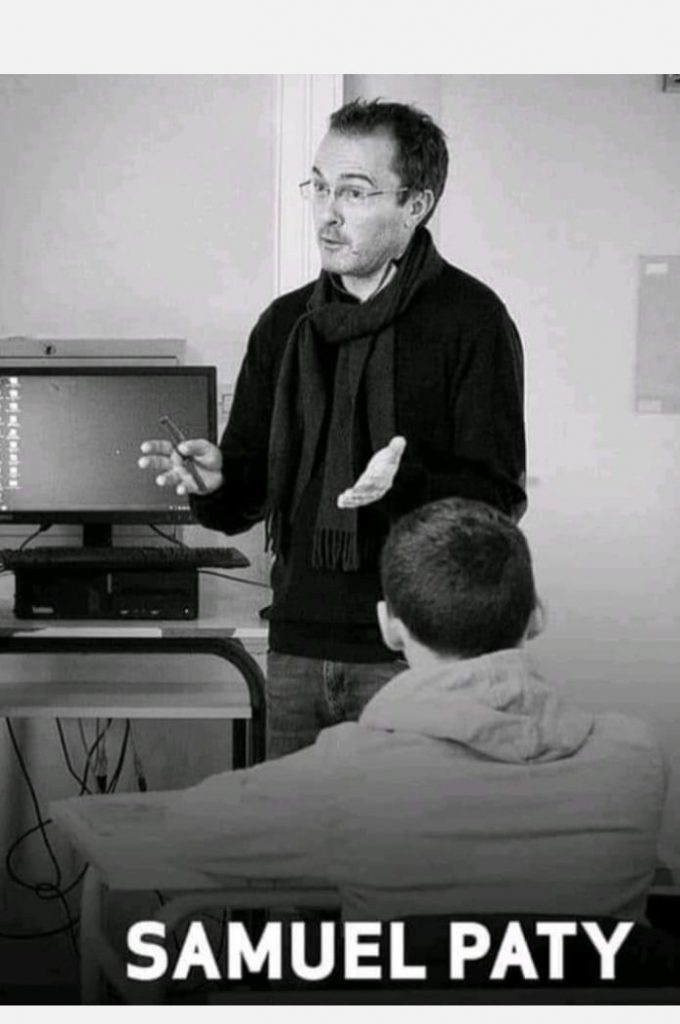
The event was the assassination of Samuel Paty, a french history teacher. He was beheaded in front of the school where he teached because, during a lesson, he showed some Charlie Hebdo’s caricatures. The reason for this, was to explain the religious fanatism and freedom of speech.
The person who killed Samuel Paty attacked not only a French person but also the freedom of speech which is a fundamental and universal right. That’s why this assassinate should concern every country and every population. This assassination reminds us of how important it’s to have the freedom to express ourselves by writing, drawing and speaking.
It’s also the values of the respect of the differences, the cultural and religious diversity which were touched by this decapitation.
I hope that this article could start some useful discussions between people, and help developing more empathy between each other across different cultures, languages and religions. I can confirm that it’s possible to live in harmony together by my own experience. Indeed, I’m living an international experience with volunteers from others countries than mine.
If you want to share something like a drawing, a quote which illustrates love, tolerance, empathy, you can do it on the comments. I will be happy to answer to you and to discuss with you 🙂
—
Astăzi vreau să vă povestesc despre un eveniment ce mi-a afectat viața ca voluntar, persoană şi cetățean.Acest eveniment a avut loc în Franța, pe 16 octombrie 2020.
Evenimentul a fost asasinarea lui Samuel Paty, profesor de istorie.A fost decapitat în fața şcolii unde a predat pentru că, în timpul unei lecții a arătat câteva caricaturi ale lui Charile Hebdo.Motivul pentru care a făcut acest lucru a fost acela de a explica fanatismul religios şi libertatea de exprimare.
Persoana care l-a ucis pe Samuel Paty a atacat nu numai un individ francez, cât şi libertatea de exprimare, care este un drept fundamental şi universal. De aceea, acest asasinat ar trebui să preocupe fiecare țară şi fiecare populație. Acest asasinat ne aminteşte cât de important este să avem libertatea de a ne exprima scriind, desenând şi vorbind.
De asemenea este vorba şi despre valorile respectului diferențelor, diversității culturale şi religioase ce au fost atinse prin aceasta decapitare.
Sper că acest articol va da startul unor discuții constructive între oameni şi va contribui la dezvoltarea empatiei acestora, cât şi între diferitele culturi, limbi şi religii.Pot confirma faptul că este posibil să trăim în armonie din propria mea experiență în care trăiesc cu voluntari din alte țări.
Dacă doriți să împărtăşiți ceva de genul unui desen, un citat ce ilustrează dragostea, toleranța, empatia, îl puteți lăsa în comentarii.Voi fi bucuros să vă răspund şi să vorbim.
Portret de voluntar – Johannes (Suedia)
Hi, my name is Johannes Franzen. I am 21 years old, I grew up in a small town in northern Sweden called Ostersund. I studied media production and marketing. In my spare time I like to cook and to study history and also hiking. I am interested in learning more about history especially European and also to learn more about different cultures and all that are less well known.
I wanted to go on a long term volunteering project because i enjoy the adventure of living in a foreign country and to feel like I develop more as a person and like I accomplish something more than I would on a short term project. I have already been on one short term trip and after that I have been looking for a long term project. The reason why I chose to discover Teișani is because it had to do with what i studied in high school (media production) and it was a great chance to experience a new culture on a deeper level than if I were a tourist.
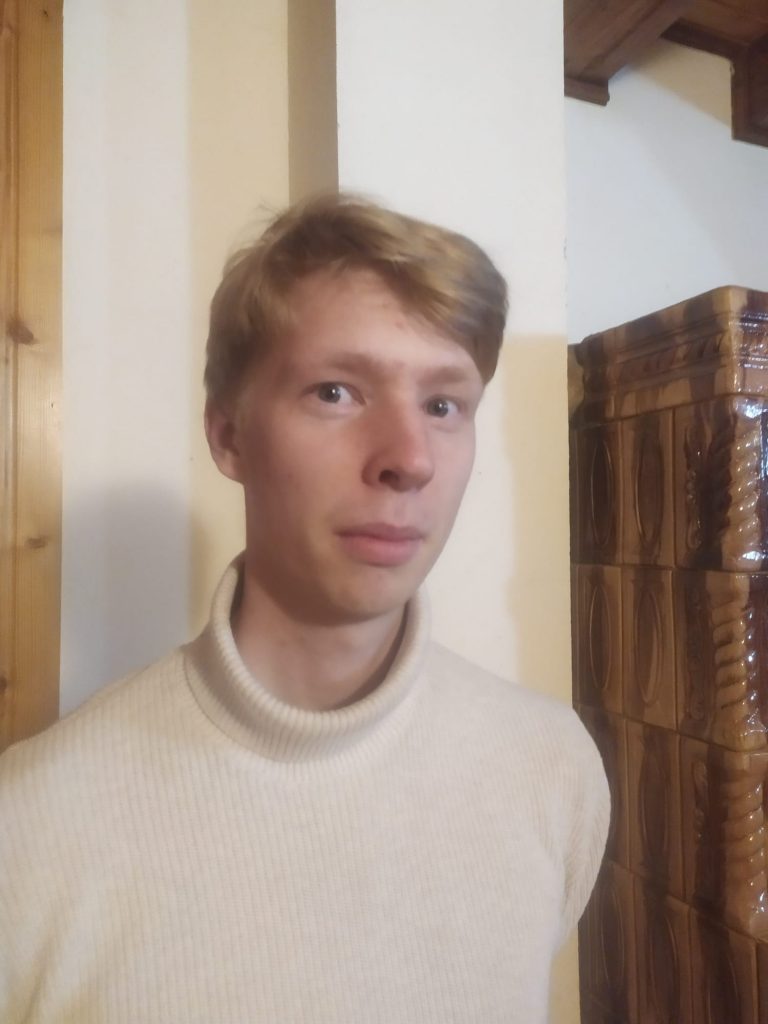
Bună, numele meu e Johannes Franzen. Am 21 de ani, am crescut într-un oraș mic din nordul Suediei numit Ostersund. Am studiat producție media și marketing. În timpul liver îmi place să gătesc și să studiez istorie, precum și drumețiile. Sunt interesat de a învața mai multe despre istorie, mai ales europeană, precum și să învăț mai multe despre diferite culturi și tot ceea ce e mai puțin cunoscut.
Am vrut să merg într-un proiect de voluntariat de termen lung deoarece mă bucur de aventura de a trăi într-o țară străină și de a mă simți de parcă mă dezvolt mai mult ca persoană și de parcă realizez ceva mai mult decât aș face-o într-un proiect de scurtă durată. Am fost deja într-o excursie de scurtă durată și după aceea am fost în căutarea unui proiect de lungă durată. Motivul pentru care am ales să descopăr Teișani este acela că a avut de aface cu ceea ce am studiat în liceu (producție media) și a fost o șansă minunată de a experimenta o nouă cultură la un nivel mai profund decât dacă aș fi un turist.
Portret de voluntar – Josué (Mexic + Spania)
Hi, my name is Josué and I´m from Andalucia, Spain. However I also have my Mexican side – I was born there and all my family is Mexican. I am 20 years old and I have officially been studying technological and scientific stuff. Nevertheless, I love to learn and study other disciplines in my free time, such as history, languages, music or even audiovisuals; I also spend a lot of time playing videogames (more than I would like to admit). I’ve been living in the Iberian peninsula since I was six years old and I never had the chance to travel to the rest of Europe until now – through European solidarity corps. I spent two months working on the new Teișani youth centre and it was a very good experience, so I decided to spent more time here and keep improving the skills that I think I need in order to become the person I want to be.
As for my future plans, I would really like to keep traveling, learning languages and know the cultures behind them. And also at some point resume my studies and go to univerity to study engineering.
If you ask me, I would say I’m not the kind of guy who cheers up the place, but I love to follow and keep the good vibes around me, so we all could be cool with each other.
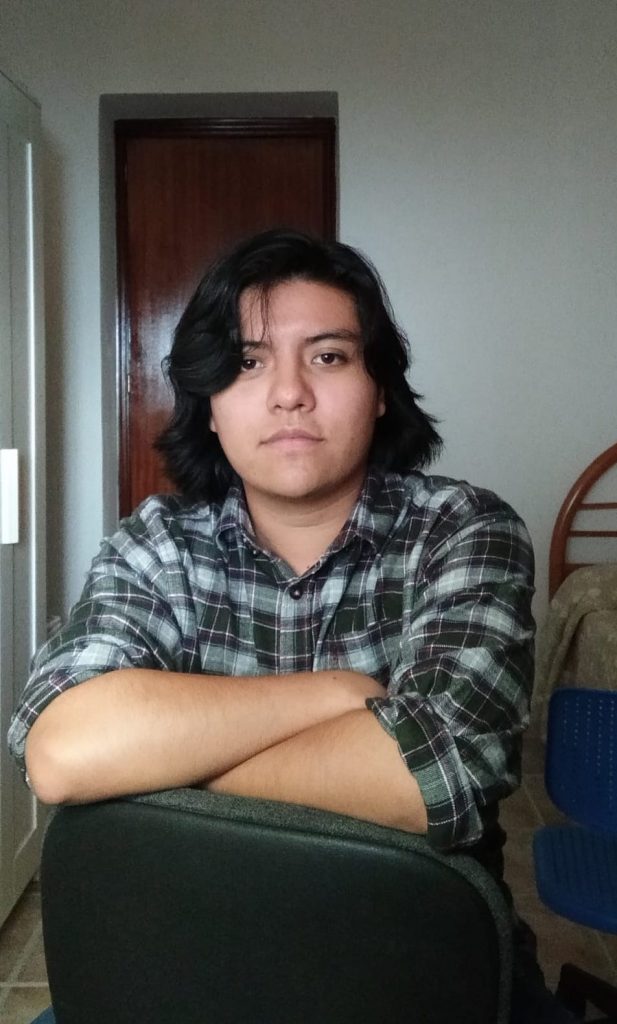
Bună, numele meu este Josué și sunt din Andalucia, Spania. Cu toate acestea, am și o parte mexicană, având în vedere că m-am născut acolo și toată familia mea este mexicană. Am 20 de ani și, oficial, am studiat lucruri tehnologice și științifice. Pe lângă acestea, îmi place să învăț și să studiez cât mai multe discipline în timpul meu liber cum ar fi historia, limbile străine, muzica sau chiar domeniul autovizual; deasemenea, petrec foarte mult timp jucându-mă jocuri video. În ciuda faptului că am trăit în Peninsula Iberică de când aveam 6 ani, n-am avut niciodată ocazia să călătoresc în restul Europei până acum, prin intermediul Corpului European de Solidaritate. Mi-am petrecut două luni lucrând la noul centru de tineret din Teișani și a fost o experiență foarte plăcută, așa că am decis să petrec mai mult timp aici și să îmi dezvolt abilitățile de care eu consider că am nevoie pentru a deveni persoana care vreau să fiu.
În ceea ce privește planurile mele de viitor, mi-aș dori să continui să călătoresc, să învăț limbi străine și să știu culturile din spatele lor. Bineînțeles, la un moment dat, să îmi reiau studiile și să merg la universitate pentru a studia ingineria.
Dacă mă întrebați pe mine, aș spune că nu sunt genul de băiat care să binedispună oamenii din jurul lui din proprie inițiativă, ci mai degrabă genul care să mențină o atmosfera plăcută în jurul lui pentru că toată lumea să se înțeleagă bine cu toată lumea.
Portret de voluntar – Gertrudis (Spania)
My name is Gertrudis, I am 28 years old and I come from a small town near the sea in Catalonia, Spain. I have studied Audiovisual Communication and Investigative Journalism, so I am very keen on these topics. I love being creative, communicating and I am very curious and interested in knowing more about different cultures and history, especially European history. Furthermore, I am interested in social change based on ecologism, gender issues and municipalism focus. Therefore, I have been participating and working with associations related to these issues in the last few years.
Nowadays, after residing in my quiet town all my life, I wanted to experience life in a foreign country and meet people from other cultures. The European Solidarity Corps allows me to get involved in a multicultural atmosphere, so I have been looking for projects and for the chance to enjoy some of them. When I read about the Discover Teișani project, I knew it was perfect for me. It is an opportunity to know in depth about Romanian culture which is quite unknown for me even though it has strong cultural connections with my country of origin, as the Latin language. Of course, I am excited also about the idea to live in a rural area, surrounded by nature that I would love to discover, photograph and just enjoy. For the moment I need to be patient and cautious due to the lockdown we need in these times, but these measures will be worthwhile.

Numele meu este Gertrudis, am 28 de ani și provin dintr-un oraș mic de lângă mare în Catalonia, Spania. Am studiat Comunicare Audiovizuală și Jurnalism Investigativ, deci sunt foarte pasionată de aceste subiecte. Iubesc să fiu creativă în comunicare și sunt foarte curioasă și interesată în a cunoaște mai multe despre diferite culturi și despre istorie, mai ales istorie europneană. De asemenea, sunt interesată de schimbare socială bazată pe ecologism, pe probleme de gen și centrare pe municipalism. Așadar, am participat și am lucrat cu asociații legate de aceste probleme în ultimii ani.
În prezent, după ce am locuit în orașul meu liniștit toată viața, am vrut să experimentez viața într-o țară străină și să întâlnesc oameni din alte culturi. Corpul Europnean de Solidaritate îmi dă voie să mă implic într-o atmosferă multiculturală, deci am fost în căutare a proiectelor și a șansei de a mă bucura de unele dintre ele. Când am citit despre proiectul Discover Teișani, am știut că este perfect pentru mine. Este o oportunitate de a cunoaște în profunzime lucruri despre cultura română, care îmi este destul de necunoscută chiar dacă se află în strânsă legătură cu cultura țării mele originare, precum limbile romanice. Desigur, sunt entuziasmată de asemenea de ideea de a trăi în mediul rural, înconjurată de natura pe care mi-ar plăcea să o descopăr, fotografiez și de care pur și simplu să mă bucur. Pentru moment trebuie să am răbdare și să fiu precaută din cauza carantinei de care avem nevoie în aceste momente, dar aceste măsuri vor merita.
Portret de voluntar – Andrea (Italia)
Hi, my name is Andrea, I’m from Italy and for this year I’m one of the volunteers for Curba de Cultură here in Romania.
During the summer I was really confused about what to do about my life, to continue my studies in another country or find something new to develop and build my experience?When I saw the project Discover of Teisani I thought: ‘’Finally something that goes in the same direction in which I want to go’’. Covid 19 was and certainly still is a particular issue that can arrest people from having any kind of personal experiences in other countries, but in that moment I felt a sensation that strongly pushed me in to the project. I think that I made the right choice. There are a lot of people that, like me, are feeling disoriented after they complete their studies, especially in sociological or anthropological fields. I think that this can be the perfect place for people that share this type of passion and objectives.
Apart from this, I’m 24 and, as I said, I recently finished my bachelor in intercultural communication in Turin, Italy. My dream is to make documentaries, write articles and monographs around the world to any kind of association that works to promote the territory, the people and the local culture.About the place I am in, I really suggest it for those who love nature and for those who want an unconventional life experience despite the standard and the comfort that city offers. Being warm is wonderful, but being warm thanks to your own fire has completely another taste.
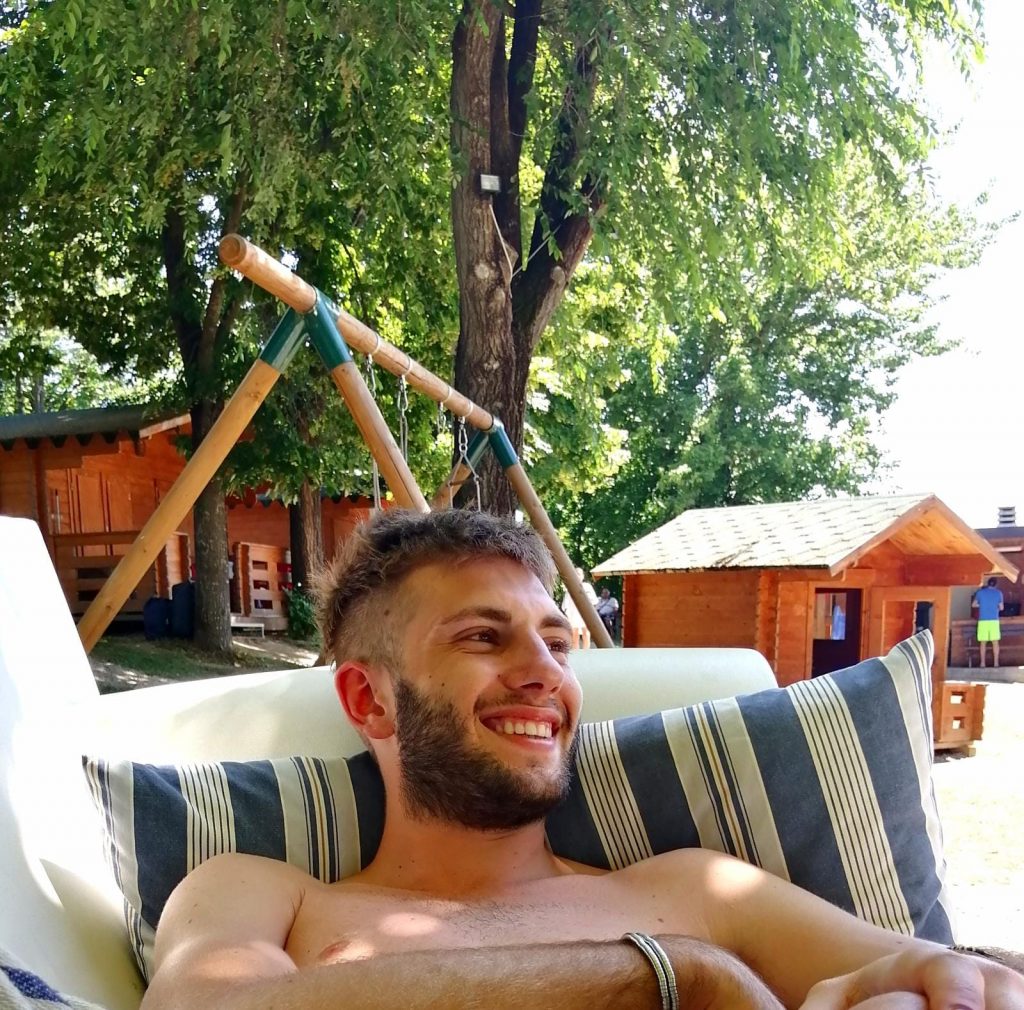
Bună, numele meu este Andrea, sunt din Italia și pentru anul acesta sunt unul dintre voluntarii Curbei de Cultură, aici în România.
Pe timpul verii am fost foarte confuz când vine vorba de ce să fac cu viața mea, să îmi continui studiile într-o altă țară sau să găsesc ceva nou pentru a îmi dezvolta și construi experiența?Când am văzut proiectul Discover Teișani m-am gândit: ”În sfârșit ceva care merge în aceeași direcție în care îmi doresc și eu să mă duc”. Covid 19 a fost și cu siguranță încă este o problemă specifică ce poate să oprească oamenii din a avea orice fel de experiențe personale în alte țări, dar în acel moment am simțit o senzație care m-a împins puternic spre proiect. Cred că am făcut alegerea corectă. Sunt multe persoane care ca și mine se simt dezorientate după ce își termină studiile, mai ales în domeniul sociologiei sau antropologiei. Consider că acesta poate fi locul perfect pentru persoanele care împărtășesc astfel de pasiuni și obiective.
Pe lângă asta, am 24 de ani și, așa cum am menționat, mi-am terminat de curând licența în comunicare interculturală în Turin, Italia. Visul meu este să fac documentare, să scriu articole și să monografiez în jurul lumii pentru orice fel de asociație care lucrează la promovarea teritoriului, a oamenilor și a culturii locale. În ceea ce privește locul în care mă aflu, îl recomand celor care iubesc natura și celor ce își doresc o experiență de viață neconvențională în pofida standardelor și confortului pe care orașul le oferă. E minunat să ai căldură, dar să ai căldură mulțumită propriului tău foc are cu totul alt gust.
How the visit to the landfill raise awareness of young people / Cum o vizită la groapa de gunoi i-a făcut pe tineri mai conștienți
On the 20th of June happened a trip to the landfill (first one organized by me) with EVS volunteers as well as local volunteers. During organization I asked to be a bit more specific with details to cause more impact since the participants majority of them were adult of teens so I wanted the visit to cause impact on them. 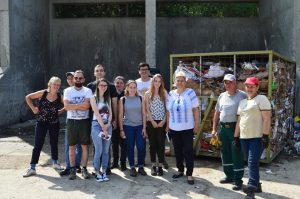
During the visit we had a lot of information with a lot of numbers we were given a lot of information about the different stages of waste sorting and how do they deal with the waste. For example what happens after the truck passes your house and takes your recyclables?.
They go to the landfill and are sorted manually by the employees of the sorting center and then they go different machines to be pressed and packed and after that according to the material (paper, plastic of different colors, glass) these new pressed and packed recyclables are sold to other companies in Prahova and these take over the recycling process.
 Ok so now you know what happens to the recyclables what about the rest of the trash?
Ok so now you know what happens to the recyclables what about the rest of the trash?
Well that was the shocking part in my opinion. The rest of the trash ends up in the landfill, which is currently reaching the maximum amounts and will soon have to be sealed!
The landfill has licence for 10 more years and if it keeps getting the trash at this rate will be sealed in less than 4 years. I think that the next step is to not throw everything together to the trash and pay even more attention and spread more the word about recycling.
All of this was very interesting in a point for us EVS to compare this system from what it is back in our countries. I know for me there are a lot of differences.
Just to finish this little Landfill visit walkthrought I wanted to point out that due to financial reasons a big part of the equipment that they have is not working because they don’t have the money for it and so on they need to use smaller machines which slows the process.
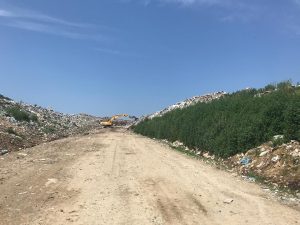
(Mountain of trash from the landfill)
After the visit I asked some question to the participants about the visit and got some very interesting answers and I was very pleased with them because I saw that the visit actually had some impact on them.
The questions were:
1– What kind of information did the visit to the landfill gave to you?
2– What was the thing that shook you the most?
3– What do you think we can do to change this situation?
The answer for questions one and two were pretty general most of the participants said that they got information that couldn’t get anywhere else, that there is a lot of waste coming to the landfill from very small areas, the people around don’t recycle enough and that the landfill didn’t had enough money to develop recycling process and to deal with more trash.
What shook them the most was pretty general as well and majority of the answer say that machines not working due to financial problems, the amount of trash that gets there and the lack of recycling around the commune.
When it comes to answer number three that’s where things spice up a little bit from revolution to “convince big players” against the use of plastic to spread the word and promote the idea of recycling but there is one answer that really stands out and I would like to share it with you.
“At the beginning a serious campaign to inform people what they can throw in their trash-bin( ex: that the
biodegradable stuff should not be put in there), the calendar for recycling materials( usually people loose the
counting and don’t know in which Wednesday the truck will come), what is the process at the landfill(some shocking
facts to trigger something in the people ́s minds) eventually to talk with a city hall representative and find together a
solution to deliver that information to the population. I strongly believe that we should work not only with kids, but also with
the grown ups because the decision about waste is in their hands and they really need a good speech in order to
start paying more attention to their waste.”
So does/did the landfill raised awareness to the young people?
I would say YES. At the end I got very good feedback and very good ideas and arguments regarding what they’ve saw in the landfill and also not only the participants but also me I was super shocked with all the info and I felt that we should do something about it. Visiting your local landfill is something that I really recommend specially if you are concerned with this environmental topic because you’ll see things that you never thought about it and in the end you’ll learn new stuff and you will see the reality of it.
I would like to thank Georgeta Marcu, responsible for environmental protection of the place and our guide who explained everything super clear and of course thanks to all the participants.
—
Pe 20 iunie a avut loc o excursie la depozitul de deșeuri (prima dată organizată de mine) cu voluntari EVS, precum și voluntari locali. În timpul organizării am cerut să fie un pic mai specific cu detalii pentru a provoca un impact mai mare, deoarece majoritatea participanților erau adulți sau adolescenți, am dorit ca vizita să provoace un impact asupra lor.
În timpul vizitei am primit multe informații cu o mulțime de numere, ni s-au oferit multe informații despre diferitele etape ale sortării deșeurilor și cum trebuie să se ocupe de acestea. De exemplu, ce se întâmplă după ce camionul trece pe la casa ta și îți ia reciclabilele.
Se duc la depozitul de deșeuri și sunt sortate manual de către angajații centrului de sortare, apoi merg spre diferite mașini pentru a fi presate și ambalate iar, după aceea, în funcție de material (hârtie, plastic de diferite culori, sticlă) noile reciclabile presate și ambalate sunt vândute altor companii din Prahova acestea preluând procesul de reciclare.
Bine, deci acum știți ce se întâmplă cu reciclabilele, dar cum rămâne cu restul de gunoi?
Ei bine, aceasta a fost partea șocantă, în opinia mea. Restul de gunoi ramâne în depozitul de deșeuri, care atinge în prezent limitele maxime și în curând va trebui să fie sigilat!
Depozitul are licență încă 10 ani și, dacă va continua să primească gunoi, va fi sigilat în mai puțin de 4 ani. Cred că, următorul pas este să nu aruncați totul la coșul de gunoi și să acordați și mai multă atenție cât și să răspândiți mai mult idea despre reciclare.
Toate acestea au fost foarte interesante dintr-un punct de vedere pentru voluntarii EVS pentru a compara acest sistem cu ceea ce este în țările lor. Știu că în cazul meu există o mulțime de diferențe.
Tocmai pentru a termina această mică vizită a depozitului de deșeuri, am vrut să subliniez că, din motive financiare, o mare parte din echipamentele pe care le au…nu funcționează, deoarece nu au bani pentru asta, deci trebuie să folosească mașini mai mici, care încetinesc procesul.
După vizită, am pus niște întrebări participanților despre vizită și am primit câteva răspunsuri foarte interesante și am fost foarte mulțumit de ei, deoarece am văzut că vizita a avut efect asupra lor.
Întrebările au fost:
1– Ce fel de informații ți-a oferit vizita la depozitul de deșeuri?
2– Care a fost lucrul care te-a șocat cel mai mult?
3– Ce crezi că putem face pentru a schimba această situație?
Răspunsurile la primele două întrebări au fost destul de generale, majoritatea participanților au spus că au primit informații pe care nu le pot primi din altă parte, că există o mulțime de deșeuri care ajung în depozitul de deșeuri din zone foarte mici, oamenii din jur nu reciclează suficient și respectiv că depozitul de deșeuri nu a avut suficienți bani pentru a dezvolta procesul de reciclare și pentru a face față mai multor gunoi.
Răspunsul la ceea ce i-a șocat cel mai mult a fost destul de general de asemenea și majoritatea se referă la mașinile care nu funcționează din cauza problemelor financiare, cantitatea de gunoi care ajunge acolo și lipsa de reciclare în jurul comunei.
Când vine vorba de răspunsurile de la numărul trei, acesta este locul în care lucrurile se încing puțin când e vorba de a convinge „marii jucători” împotriva utilizării plasticului pentru a răspândi și a promova ideea de reciclare, dar există un răspuns care într-adevăr iese în evidență și pe care aș vrea să-l împărtășesc cu voi.
“La început, trebuie o campanie serioasă de informare a oamenilor despre ce pot arunca în coșul de gunoi (ex: că nu trebuie introduse materialele biodegradabile acolo), calendarul pentru reciclarea materialelor (de obicei oamenii pierd numărarea și nu știu în care miercuri va veni camionul), care este procesul de la depozitul de deșeuri (unele fapte șocante pentru a declanșa ceva în mintea oamenilor), iar în cele din urmă, pentru a discuta cu un reprezentant al primăriei și pentru a găsi împreună o soluție pentru a furniza aceste informații populației. Cred cu tărie că ar trebui să lucrăm nu numai cu copiii, ci și cu cei mari, deoarece decizia despre deșeuri este în mâinile lor și au nevoie cu adevărat de un discurs bun pentru a începe să acorde mai multă atenție deșeurilor lor. ”
Prin urmare vizita la depozitul de gunoi a făcut conștientizarea tinerilor?
Aș spune DA. La final am primit un feedback foarte bun dar, și idei și argumente foarte bune cu privire la ceea ce au văzut în depozitul de gunoi și, de asemenea, nu numai participanții, dar și eu, am fost super șocat cu toate noutățiile și am simțit că ar trebui să facem ceva în acest sens. Vizitarea depozitului vostru local ar fi un lucru pe care îl recomand cu adevărat, în special dacă sunteți preocupat de acest subiect despre mediu, deoarece veți vedea lucruri la care nu v-ați gândit niciodată și, în final, veți învăța lucruri noi și veți vedea realitatea acestuia.
- Aș dori să îi mulțumesc Georgetei Marcu, responsabilă cu protecția mediului locală și ghidului nostru care a explicat totul foarte clar și, desigur, mulțumesc tuturor participanților.
Plastic rules the world
In our project we are concerned with “teaching” children how to recycle, pointing them out what trash belongs where, what effects all the trash has on the environment, what happens to the trash when it is not sorted accordingly. We have implemented various activities in the schools in the area. We have built trash bins with students from the lower classes and discussed the different types of trash to them. In a playful way we tried to convey this knowledge, non formal education, of course.
In the higher classes we concentrated on the concrete influence of the individual in this context of environmental protection. With the students we watched videos that deal with the topic. We also talked about ways of living “greener”.
I am convinced that with our project we had an influence on the students.
But, I go into a super market, which one doesn’t matter. There I can buy organic vegetables, which are packed in plastic, so that they don’t come into contact with the other vegetable, which is called inferior. I can buy electronic devices for a low price, whose packaging (made of plastic, of course) is so complicated to open, that I have to buy scissors to open it, made of plastic, of course. (I don’t want to talk about the manufacturing process of the devices at this point, that would lead too far.) When I have slowly filled my shopping cart with stuff to eat, go to the bathroom and load my fancy mobile phone, my shopping cart is already so full of plastic that I would like to leave it standing. But, according to maslow’s pyramid of needs, I have to, at least eat and go to the bathroom. So I buy all the stuff and I am happy that I have saved a little money because the supermarket is so crassly cheap. Of course I forgot my various jute bags, so I have to buy plastic bags. Also due to the fact that the charming cashier doesn’t let me use the carton box I found in his well-assorted supermarket. I could at least burn the box without a guilty conscience. Well then, I have to eat.

The supermarket is an indication of how far we have come in terms of environmental protection. And it doesn’t matter whether it’s a supermarket in Germany or Romania. Plastic is everywhere. The companies market themselves as green companies, because it is socially desirable and the managers try to get good promo. But the content of the supermarkets reflects a different picture.
As I said, in our project we try to draw attention to a conscious life in the environment. But large companies are always pointing out limits to me. Of course I can teach the children to recycle things and talk to them about the environment. But it doesn’t reduce the amount of plastic produced. So we need to fight the causes. I do not believe that the market regulates itself. That is a neo-liberal misbelief.
So should politics set limits on the market? I am in favor of it. But that demands voters. People hate laws. I can fully understand that. But something has to happen.
I can shop in a fancy shop that sells stuff without packaging. But I don’t find it in rural Romania or Germany. For that I would have to drive into a city. And since there is no bus after 20h, I would have to go there with my diesel and shop in a shop that I can’t afford. So I would contaminate the environment with my diesel, as well as what I find worse as a selfish person (sorry environment)! Because I can’t do my weekly shopping in this shop. So i would starve!
I have no recipe to solve this problem. Maybe time will heal all wounds and in 50 years there will be no more plastic packaging. In any case, it makes a lot of sense to make the people (in my case young people) aware of the environment, to be more attentive and to consciously separate the trash. Even if it doesn’t affect the owner of the supermarket and he doesn’t change his behavior.
After all, the young people’s consciousness is changing and more and more people are going on the streets. Well, a start!
Schimb de Tineri în Sicilia / testimoniale participanților
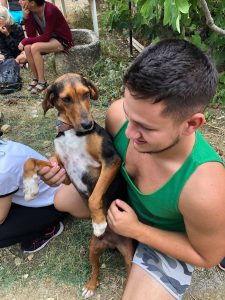 În prima săptămână a lunii septembrie, o echipă formată din 5 tineri din Curba de Cultura s-a alăturat unui schimb de tineret Erasmus + la Polizzi Generosa, în inima Siciliei. HeritAge, un schimb dedicat împărtășirii de practici despre construcția naturală a fost organizat de noii noștri parteneri sicilieni, Porto di Terra. Iată cum au descris tinerii noștri această experiență specială în inima naturii:
În prima săptămână a lunii septembrie, o echipă formată din 5 tineri din Curba de Cultura s-a alăturat unui schimb de tineret Erasmus + la Polizzi Generosa, în inima Siciliei. HeritAge, un schimb dedicat împărtășirii de practici despre construcția naturală a fost organizat de noii noștri parteneri sicilieni, Porto di Terra. Iată cum au descris tinerii noștri această experiență specială în inima naturii:
“Despre această nouă experiență pot spune că a fost unică cu noi oameni cu caractere diferite. Am trăit experiența de a construi acoperișul unei “paglaio” folosind doar materiale naturale “cannedda” și “tisa”, și de a consolida pereții unei alte “paiaio” folosind din nou doar materiale naturale, lut nisip apă fan pământ galben”. Pentru mulți dintre noi a fost o experiență nouă în care am interacționat direct cu locul cu materialele absolut cu toată natură, iar cu siguranță pentru mine a fost prima dată când am interacționat direct doar cu materiale naturale chiar dacă știam de existența și folosirea lor. Am experimentat un nou stil de viață în care am dormit toată perioada proiectului în cort, am experimentat mâncărurile tradiționale dar într-o varianta vegetariană descoperind posibilitatea de a adopta un nou stil de alimentație. După o drumeție de aproape 5 ore în munții sicilieni am rămas cu imaginea unei familii de căprioare care conviețuiau împreună cu o familie de porci mistreți și bineînțeles cu imagini ale peisajului de neuitat. După vizita celui mai apropiat orășel de camping-ul nostru am rămas cu detalii despre istoria orășelului cum a fost construit, cum majoritatea persoanelor tinere l-au părăsit treptat, cum majoritatea bisericilor au fost transformate în case. În ultima seară a proiectului ne-am luat rămas bun de la loc de la toți noii noștri prieteni făcuți pe parcursul schimbului, pe ritmuri de muzică tradițională cântate de invitații noștri locali pentru a celebra noul acoperiș și noua imagine a pereților din casele naturale.” – Alex
 “Unul dintre cele mai importante aspecte ale acestui schimb de tineri a implicat bucuria și vibe-ul pozitiv pe care îl pot produce lucrurile simple. Într-o societate care pune accent pe ideea de a aprecia cât mai mult partea materială, am întâlnit aici, la Porto di Terra comuniunea perfectă între om și natură. O adevărată atmosfera relaxată și relaxantă, oameni mereu zâmbitori și înțelegători. Împreună cu tinerii din Spania, Italia, Portugalia, Slovacia și Grecia am adunat și pregătit materialele necesare, am reconstruit două dintre casele tradiționale, denumite Pagliaio și am explorat frumusețile parcului național Maddona printr-o vizită în orașul Polizzi Generossa și în special printr-o drumeție pe munte. Schimbul de tineri s-a încheiat cu dans, muzică live tradițională și multă bucurie pe fețele tuturor.” – Simina
“Unul dintre cele mai importante aspecte ale acestui schimb de tineri a implicat bucuria și vibe-ul pozitiv pe care îl pot produce lucrurile simple. Într-o societate care pune accent pe ideea de a aprecia cât mai mult partea materială, am întâlnit aici, la Porto di Terra comuniunea perfectă între om și natură. O adevărată atmosfera relaxată și relaxantă, oameni mereu zâmbitori și înțelegători. Împreună cu tinerii din Spania, Italia, Portugalia, Slovacia și Grecia am adunat și pregătit materialele necesare, am reconstruit două dintre casele tradiționale, denumite Pagliaio și am explorat frumusețile parcului național Maddona printr-o vizită în orașul Polizzi Generossa și în special printr-o drumeție pe munte. Schimbul de tineri s-a încheiat cu dans, muzică live tradițională și multă bucurie pe fețele tuturor.” – Simina
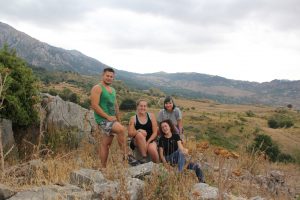 “Heritage”…un Youth Exchange într-o altă lume,un schimb care m-a rupt de realitate și care mi-a dat o bună lecție de viață. Subiectul acestui schimb a fost despre construcțiile din materiale naturale. Campingul a fost într-o pădurice, mâncarea a fost vegetariană,din produse naturale crescute în grădina organizatorilor. Am învățat să construim pagliaio, o căsuța pe care foarte puțini oameni mai știu să o facă. Acoperișul constă din mănunchiuri de disa și cannedda, iar pereții dintr-un amestec făcut din paie,pământ galben și nisip cu calcar. Într-una din zile am vizitat satul Polizzi Generosa căruia i-am descoperit istoria și un atelier de lucru în lut unde am fost lăsăți să experimentăm tainele lutului. O altă zi a fost dedicată urcatului pe munte. Până în vârf am întâlnit căprioare și porci mistreți. În ultima zi am celebrat terminarea construirii casei “pagliao”. Subiectul schimbului și-a atins scopul foarte bine și pe lângă acesta ne-am distrat în timp ce munceam, am învățat să lucrăm în echipa și am învățat să apreciem natura,să ii vedem frumusețea în toată splendoarea ei. Mi-am înfrânt multe temeri peste care nu mă așteptăm sa trec. Din acel stil natural de viață am primit niște lecții care mă vor ajută în viață de zi cu zi.” – Andreea
“Heritage”…un Youth Exchange într-o altă lume,un schimb care m-a rupt de realitate și care mi-a dat o bună lecție de viață. Subiectul acestui schimb a fost despre construcțiile din materiale naturale. Campingul a fost într-o pădurice, mâncarea a fost vegetariană,din produse naturale crescute în grădina organizatorilor. Am învățat să construim pagliaio, o căsuța pe care foarte puțini oameni mai știu să o facă. Acoperișul constă din mănunchiuri de disa și cannedda, iar pereții dintr-un amestec făcut din paie,pământ galben și nisip cu calcar. Într-una din zile am vizitat satul Polizzi Generosa căruia i-am descoperit istoria și un atelier de lucru în lut unde am fost lăsăți să experimentăm tainele lutului. O altă zi a fost dedicată urcatului pe munte. Până în vârf am întâlnit căprioare și porci mistreți. În ultima zi am celebrat terminarea construirii casei “pagliao”. Subiectul schimbului și-a atins scopul foarte bine și pe lângă acesta ne-am distrat în timp ce munceam, am învățat să lucrăm în echipa și am învățat să apreciem natura,să ii vedem frumusețea în toată splendoarea ei. Mi-am înfrânt multe temeri peste care nu mă așteptăm sa trec. Din acel stil natural de viață am primit niște lecții care mă vor ajută în viață de zi cu zi.” – Andreea
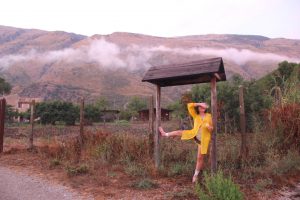 “Probabil primul Schimb de Tineri din experiența mea când am făcut cu adevărat un schimb. Am învățat mult prin lucrări practice, luând informații și povești și, de asemenea, de la modelele pe care le-am găsit între oamenii cu care am petrecut săptămâna aceasta. Am lăsat acolo mica mea contribuție la pagliaio (casele tradiționale siciliene) și am primit atât de multe: cunoștințe despre natură și puterea ei, noi prietenii, „cea mai bună mâncare pe care o vei mânca vreodată” și prima mea reprezentație live, am cântat singura jumătate dintr-un cântec pe care îl pot cânta la chitară și a însemnat foarte mult pentru mine. Sunt recunoscătoare pentru această săptămână diferită din viața mea și pentru toate ființele uimitoare pe care le-am cunoscut, inclusiv câinii și țânțarii. ”(Citiți în timp ce ascultați https://youtu.be/Op0dN_U4L5s) – Laura
“Probabil primul Schimb de Tineri din experiența mea când am făcut cu adevărat un schimb. Am învățat mult prin lucrări practice, luând informații și povești și, de asemenea, de la modelele pe care le-am găsit între oamenii cu care am petrecut săptămâna aceasta. Am lăsat acolo mica mea contribuție la pagliaio (casele tradiționale siciliene) și am primit atât de multe: cunoștințe despre natură și puterea ei, noi prietenii, „cea mai bună mâncare pe care o vei mânca vreodată” și prima mea reprezentație live, am cântat singura jumătate dintr-un cântec pe care îl pot cânta la chitară și a însemnat foarte mult pentru mine. Sunt recunoscătoare pentru această săptămână diferită din viața mea și pentru toate ființele uimitoare pe care le-am cunoscut, inclusiv câinii și țânțarii. ”(Citiți în timp ce ascultați https://youtu.be/Op0dN_U4L5s) – Laura
5 favorite outdoor games from my childhood that anyone can play
When I was young, I was scout. We spent a lot of time outdoor to play at several game.
Some of them are engraved in my mind like these 5:
- ” The bandmaster “
Everybody is in a circle. We choose one who will be “ the detective “. His goal is to find the bandmaster who is hidden among the musicians. The detective goes out of the circle to not see when the group choose ” the bandmaster “. The goal of the bandmaster is to do some movements that all the group follows, anything he wants without being spotted by the detective. He can change the movement when he wants but with care so the detective won’t see him!
The game starts, the bandmaster does a movement and everybody reproduces it. The detective comes back in the circle and tries to find the bandmaster. When he finds him, the game ends and we can restart with two other people.
- ” The mouse and the cat “
Everyone is in pairs, dispersed all over in the room/field and all of them are mice. Two participants are alone. One is the cat, the other one is also a mouse. The goal of the cat is to touch the mouse. Like this the mouse becomes the cat and vice-versa. To not be caught, the mouse needs to find a partner. For that he goes next to a couple and grabs the arm of the person just next to him. As it’s impossible to be three in a pair, the one at the opposite end needs to leave and start to run to not be caught by the cat. The game ends whenever loose interest.
- ” The king of the silence “
Everybody is in a circle, sitting or standing, it doesn’t matter. One person is “the king of the silence”, he’s sitting in the middle of the circle, eyes closed, trying to protect his treasure that is placed around the king (or under if he’s on a chair). The goal of the other people in the circle is to take the treasure. In order to do that, one by one, they go in silence to try to take it. If they do too much noise, the king is able to point them with his finger and they need to go back to their place. The game ends when the king’s treasure is stolen. The person who stole it becomes the new king and the game restarts.
- ” The wizards “
In this game, we have some wizards and the others are muggles. The goal of the wizards is to catch the muggles. When they touch them, the muggles petrify and cannot move anymore. The game ends when all muggles are petrified. But they’re able to be healed, if another muggle touches them and frees them.
- “The little goldfish”
In this game, there is a little goldfish standing in front of the others.
The goal of the other child is to get in line with him (a few meters away) and to try to cross the other side without getting touched. If they get touched, they become small goldfish and join the first fish. To do this, the children must shout: “Little goldfish, can we cross the Red Sea, if we have …?” And the little goldfish has to find a color that no one has to be able to touche a maximum of people. If someone has the color that the little goldfish has mentioned before, he can pass without fearing anything. But if a person doesn’t have the color she will have to run to try to pass the other side of the sea. The game ends when everybody is a little goldfish.
